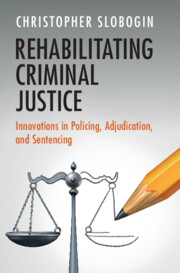Book contents
- Rehabilitating Criminal Justice
- Rehabilitating Criminal Justice
- Copyright page
- Contents
- Tables
- Preface
- Part I Policing
- 1 Equality in the Streets
- 2 Police ≠ Community Caretakers
- 3 Making Interrogation Transparent
- 4 Holding Police and Criminals Accountable
- Part II Adjudication
- Part III Post-conviction
- Notes
- Index
4 - Holding Police and Criminals Accountable
from Part I - Policing
Published online by Cambridge University Press: 17 April 2025
- Rehabilitating Criminal Justice
- Rehabilitating Criminal Justice
- Copyright page
- Contents
- Tables
- Preface
- Part I Policing
- 1 Equality in the Streets
- 2 Police ≠ Community Caretakers
- 3 Making Interrogation Transparent
- 4 Holding Police and Criminals Accountable
- Part II Adjudication
- Part III Post-conviction
- Notes
- Index
Summary
This final chapter in Part I recognizes that rules governing the police are worthless unless they are routinely enforced. Unfortunately, this chapter contends, the predominant sanction for police misconduct – the exclusionary rule – does not do the job, at least in the search and seizure setting. Because its impact is indirect and inconsistent, the rule is structurally incapable of providing robust deterrence of individual police officers carrying out searches and seizures. It is equally poor at promoting Fourth Amendment values at the departmental level. And it stultifies pro-privacy interpretations of the Fourth Amendment because of judicial heuristics that grow out of constant exposure to litigants with dirty hands. The chapter also explains why noninstrumental justifications for the rule fail to support a broad policy of exclusion. In place of the exclusionary rule, the chapter proposes an administrative penalty regime in which actions for Fourth Amendment violations would be brought directly against police officers (for bad faith actions) and departments (for negligent misconduct). This regime would be superior to the rule not only in deterring individual Fourth Amendment violations but also in encouraging use of warrants, invigorating judicial review, diminishing racism on the beat, curbing police perjury, improving hiring and training practices, and promoting citizen respect for the system.
- Type
- Chapter
- Information
- Rehabilitating Criminal JusticeInnovations in Policing, Adjudication, and Sentencing, pp. 50 - 72Publisher: Cambridge University PressPrint publication year: 2025

